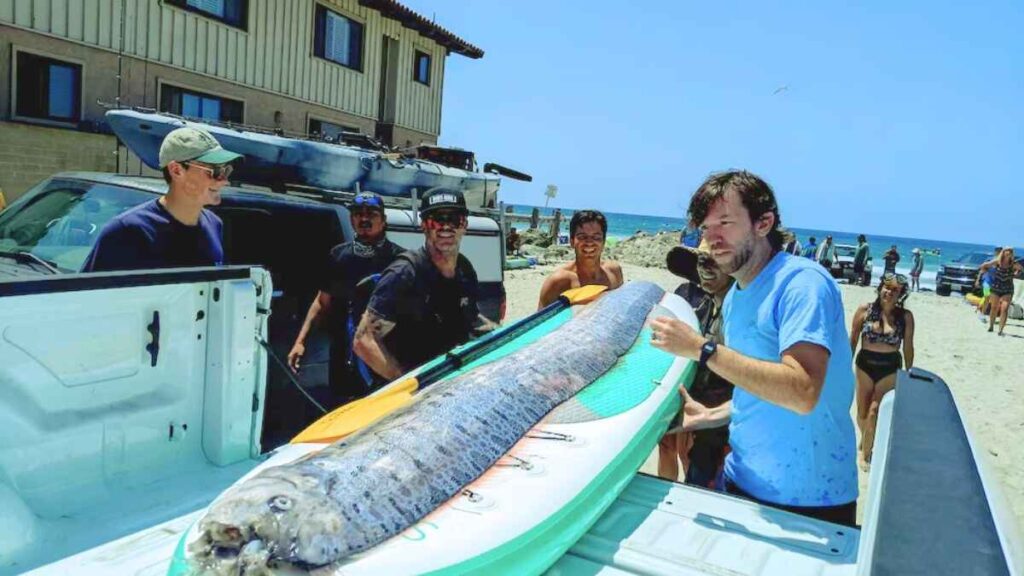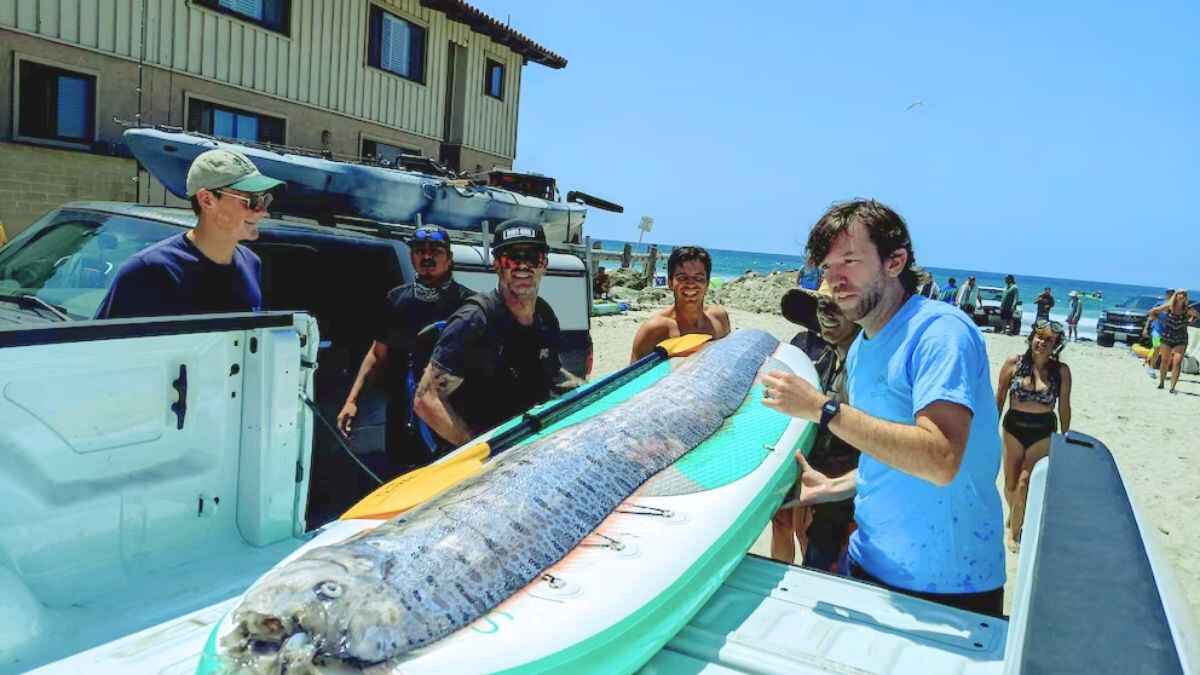San Diego Deep Sea Fish Discovery
In an extraordinary event that has captivated both locals and scientists, a rarely seen deep sea fish was discovered floating lifelessly on the ocean surface off the coast of San Diego. The 12-foot-long oarfish, resembling a mythical sea serpent, was found last weekend by an adventurous group of snorkelers and kayakers in La Jolla Cove, a scenic spot located north of downtown San Diego.
Thank you for reading this post, don't forget to subscribe!This remarkable find has not only sparked local curiosity but also drawn the attention of marine biologists keen to study this elusive creature.
The silvery oarfish, stretching an impressive 12 feet in length, was a stunning sight for those who encountered it. Oarfish are seldom seen by humans, primarily because they inhabit the mesopelagic zone, a part of the ocean so deep that sunlight fails to penetrate. The find was promptly reported to the Scripps Institution of Oceanography, a prestigious marine research center affiliated with the University of California, San Diego.


According to Ben Frable, a fish expert at Scripps, this is only the 20th recorded instance of an oarfish washing up on the shores of California since records began in 1901. The rarity of such occurrences makes this event particularly significant for marine scientists. Oarfish are known to grow even longer than the specimen found in La Jolla Cove, with some reaching lengths of over 20 feet.
Oarfish have long been shrouded in mystery and folklore, often regarded as harbingers of natural disasters, especially earthquakes. This belief is prevalent in Japanese culture, where these deep-sea dwellers are thought to predict seismic activity. However, scientific evidence supporting this correlation remains unproven. The fascination with oarfish and their supposed predictive abilities only adds to the intrigue surrounding this discovery.
Also read >> Wuhan Zoo’s Cool Strategies Combat Extreme Heat: 5 Innovative Solutions
The initial discovery of the oarfish led to an impromptu rescue mission by the snorkelers and kayakers. Utilizing a paddleboard, they managed to bring the massive fish ashore. From there, it was carefully loaded onto the bed of a pickup truck and transported to the Scripps Institution of Oceanography for further examination.
Marine biologists from both the NOAA Southwest Fisheries Science Center and Scripps have taken charge of the specimen. They planned a necropsy to be conducted on Friday, aiming to uncover the cause of death and gather valuable data on this rarely seen species. The necropsy, akin to an autopsy for animals, will involve a thorough examination of the oarfish’s internal organs and overall condition.
Oarfish, with their elongated, ribbon-like bodies and striking appearance, are among the largest bony fish in the ocean. They are primarily found in the mesopelagic zone, which ranges from 200 to 1,000 meters below the ocean surface. This zone, often referred to as the “twilight zone,” is characterized by dim light and a scarcity of food resources. Despite their size, oarfish are known to be gentle giants, feeding mainly on plankton, small crustaceans, and squid.
Also read >> China Unveils $80 Billion Gold Deposit, Largest Ever Found
The study of deep-sea creatures like the oarfish is crucial for understanding marine biodiversity and the health of ocean ecosystems. These enigmatic fish can provide insights into the biology and behavior of species that live in extreme environments. Additionally, deep-sea research helps scientists monitor the impacts of climate change and human activities on marine life.
The discovery of the oarfish has also generated significant public interest. Local residents and tourists alike are eager to learn more about this fascinating creature. The Scripps Institution of Oceanography plans to use this opportunity to educate the public about deep-sea biology and the importance of marine conservation. By engaging with the community, scientists hope to foster a greater appreciation for the ocean and its inhabitants.
The rare discovery of a 12-foot oarfish off the coast of San Diego is a reminder of the mysteries that still lie beneath the ocean’s surface. This extraordinary event has provided a unique opportunity for scientific study and public education. As researchers delve into the secrets of this deep-sea giant, we are reminded of the importance of preserving our oceans and continuing to explore the unknown realms of the natural world.
Also read >> Is TikTok a Threat? TikTok First Amendment Rights – Exploring National Security Concerns in the U.S.
What is an oarfish?
An oarfish is a deep-sea fish known for its long, ribbon-like body. It is one of the largest bony fish, capable of growing over 20 feet in length.
Where was the oarfish found in San Diego?
The oarfish was discovered at La Jolla Cove, a popular coastal area north of downtown San Diego.
How rare is it to find an oarfish in California?
It is extremely rare; only 20 oarfish have been recorded washing up in California since 1901.
Do oarfish predict earthquakes?
There is a myth that oarfish can predict earthquakes, particularly in Japanese culture, but no scientific evidence supports this claim.
What will scientists do with the oarfish?
Scientists plan to conduct a necropsy to determine the cause of death and gather data on the species.
Why is the oarfish discovery important?
The discovery is significant for scientific research on deep-sea biodiversity and offers a unique opportunity for public education on marine conservation.

